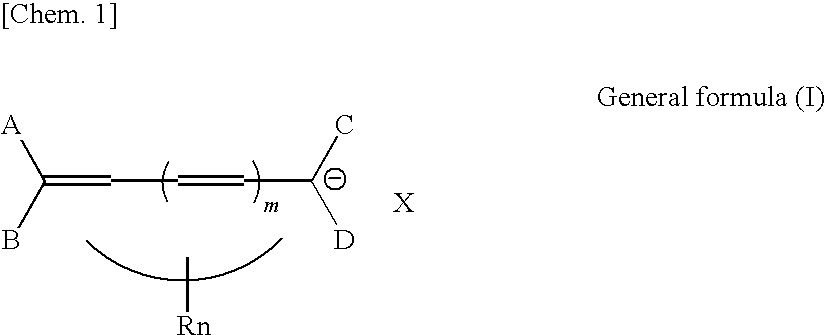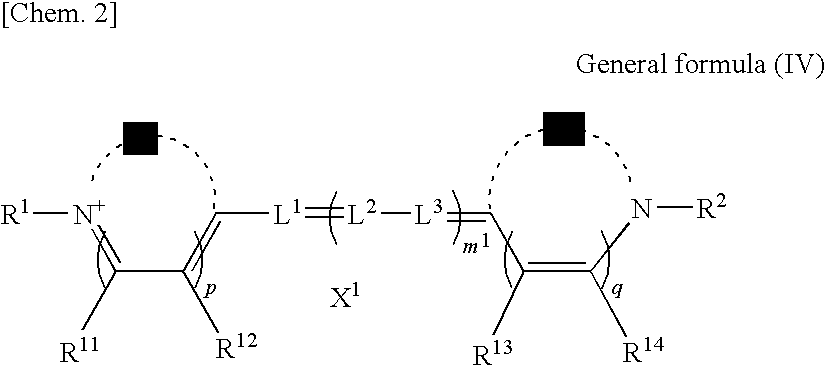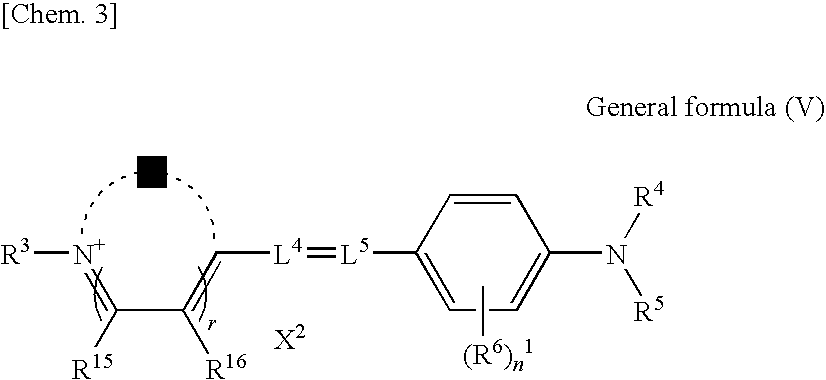Compound for photoresist, photoresist liquid, and etching method using the same
a technology of photoresist and liquid, applied in the field of compound for photoresist, photoresist liquid, and etching method using the same, can solve the problems of reducing light-emitting efficiency, difficult to consistently achieve a surface of uniform roughness, and variation in product performan
- Summary
- Abstract
- Description
- Claims
- Application Information
AI Technical Summary
Benefits of technology
Problems solved by technology
Method used
Image
Examples
example 1
Formation of Photoresist Film
[0208]A 2 g quantity of oxonol dye (Example Compound (II)-5, film λmax: 378 nm; thermal decomposition temperature: 216° C.) was dissolved in 100 mL of tetrafluoropropanol (TFP), and spin coated on a disk-shaped silicon substrate (0.6 mm in thickness, 120 mm in outer diameter, 15 mm in inner diameter) to form a coating film. The spin coating was conducted by dispensing a coating liquid on the inner circumferential portion of the substrate at a coating starting rotational speed of 500 rpm and a coating ending rotational speed of 100 rpm. The rotational speed was gradually increased to 2,200 rpm to dry the coating film. The coating film that was formed was 100 nm in thickness.
[0209]The silicon substrate on which the coating film had been formed was placed in a NEO500 made by Pulstec Industrial Co., Ltd. (wavelength: 405 nm, NA: 0.65), and a laser beam was directed onto the surface of the coating film. The laser beam irradiation conditions were as set forth ...
example 2
Formation of Irregularities
[0213]The silicon substrate processed in Example 1 was subjected to RIE etching under the following conditions from the surface side on which the coating film had been formed, after which the coating film was removed with ethanol as stripping solution. The formation of minute irregularities on the surface of the silicon substrate from which the coating film had been removed was visually confirmed. From this result, it can be understood that the coating film processed in Example 1 had functioned as an etching mask.
[0214]Etching gas: SF6+CHF3 (1:1)
[0215]Etching depth: 50 nm
examples 3 to 14
[0216]With the exception that Example Compounds given in Table 2 below were employed as oxonol dyes, pits were formed on the coating film at a 0.5 micrometer pitch in the same manner as in Example 1 by irradiation of the coating film surface with a laser beam in the same manner as in Example 1.
TABLE 3ThermalExampledecompositionCompoundλmax of film (nm)temperature (° C.)Example 3(II-1)380188Example 4(II-2)393245Example 5(II-3)385183Example 6(II-4)378200Example 7(II-16)382228Example 8(II-17)393265Example 9(II-18)385166Example 10(II-19)378220Example 11(II-20)378200Example 12(II-21)377145Example 13(II-22)462188Example 14(II-23)572237
PUM
 Login to View More
Login to View More Abstract
Description
Claims
Application Information
 Login to View More
Login to View More - R&D
- Intellectual Property
- Life Sciences
- Materials
- Tech Scout
- Unparalleled Data Quality
- Higher Quality Content
- 60% Fewer Hallucinations
Browse by: Latest US Patents, China's latest patents, Technical Efficacy Thesaurus, Application Domain, Technology Topic, Popular Technical Reports.
© 2025 PatSnap. All rights reserved.Legal|Privacy policy|Modern Slavery Act Transparency Statement|Sitemap|About US| Contact US: help@patsnap.com



